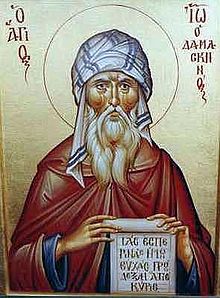John of Damascus
Syrian monk and priest
Biography
Saint John Damascene has the double honor of being the last but one of the fathers of the Eastern Church, and the greatest of her poets. It is surprising, however, how little that is authentic is known of his life. The account of him by John of Jerusalem, written some two hundred years after his death, contains an admixture of legendary matter, and it is not easy to say where truth ends and fiction begins.
The ancestors of John, according to his biographer, when Damascus fell into the hands of the Arabs, had alone remained faithful to Christianity. They commanded the respect of the conqueror, and were employed in judicial offices of trust and dignity, to administer, no doubt, the Christian law to the Christian subjects of the Sultan. His father, besides this honorable rank, had amassed great wealth; all this he devoted to the redemption of Christian slaves on whom he bestowed their freedom. John was the reward of these pious actions. John was baptized immediately on his birth, probably by Peter II, bishop of Damascus, afterwards a sufferer for the Faith.
The attainments of the young John of Damascus commanded the veneration of the Saracens; he was compelled reluctantly to accept an office of higher trust and dignity than that held by his father. As the Iconoclastic controversy became more violent, John of Damascus entered the field against the Emperor of the East, and wrote the first of his three treatises on the Veneration due to Images. This was probably composed immediately after the decree of Leo the Isaurian against images, in 730.
Before he wrote the second, he was apparently ordained priest, for he speaks as one having authority and commission. The third treatise is a recapitulation of the arguments used in the other two. These three treatises were disseminated with the utmost activity throughout Christianity.
John devoted himself to religious poetry, which became the heritage of the Eastern Church, and to theological arguments in defense of the doctrines of the Church, and refutation of all heresies. His three great hymns or "canons," are those on Easter, the Ascension, and Satin Thomas's Sunday. Probably also many of the Idiomela and Stichera which are scattered about the office- books under the title of John and John the Hermit are his. His eloquent defense of images has deservedly procured him the title of "The Doctor of Christian Art."
